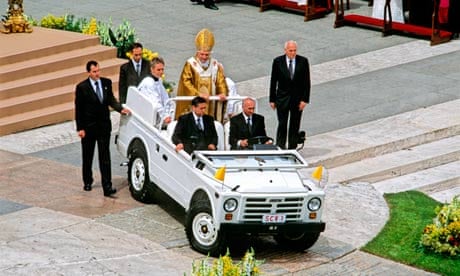Like the five million other visitors who went through the turnstiles of the Vatican Museums last year, we stared dutifully at the Stanza della Segnatura, stood in front of Caravaggio's Entombment of Christ, gawped at da Vinci's St Jerome and admired Giotto's triptych. We paid our respects to the The Laocoön and His Sons sculpture. We trooped through all the museos, salas and galleries, absorbing the culture offered by the sarcophaguses, papyruses, maps, stone tablets and animal mummies … And we hadn't even got to the best bit – the newly revamped popemobile collection and the 506-year-old museum's latest acquisition, a jeep.
It was the first Sunday of the month, when the museums are free to get in – the queue for the popemobile collection was much longer than for the Sistine Chapel. And, once inside, first impressions were just as predictable.
"Awesome!" said a young man with unsuccessful sideburns.
"Cool!" said his friend, holding his beanie over his heart. "That's some cruising wagon! The popemobile has got to be the ultimate status symbol."
The middle-aged gentleman beside them was unable to keep his coveting in check: "Now, that's some kind of rig. One that turns heads and gets you noticed at traffic lights."
Someone else just said "Wow!"

We were standing in the Pope's very own private parking space, the Padiglione delle Carrozze in the Viale Vaticano. The pope's official residence has its own railway station, petrol station and cinema. And it now has a bigger and better popemobile museum (it originally opened in 1967) with a dozen or so papamobili and nine official papal cars on permanent display in the newly enlarged museum, surrounded by portraits, saddles, lay court costumes, protocol cushions and various mobility devices employed by his holiness.
In front of the holy father's teal-coloured Mexican Beetle with whitewall tyres, two petrolheads were indulging in some petrolhead patois.
"You couldn't see him in a Nissan Almera or a Renault Espace, could you? He doesn't strike you as a Mazda man."
"Nor a Vauxhall Vectra or Chrysler Crossfire one either. But he's certainly into his bodywork."
"Must be great having a car that no one ever overtakes …"
Curiously, on his travels the pope has been driven in everything from a Lincoln to a Seat. Some of the vehicles he has used can be seen in the Mercedes-Benz museum in Stuggart and the Peugeot museum in Sochaux, France. The iconic yellow and white converted Ford truck John Paul II used on his 1979 visit to Ireland can now be hired for hen and stag dos around Dublin for €300 an hour. The armour-plated Leyland mobile throne he used for his British visit in 1982 sold for £37,000.
The Beetle was the last one to roll off the assembly line in Mexico and was presented to John Paul II after his visit in 2002. Like the other vehicles on show, it has had just one careful owner and there's hardly anything on the clock.

We moved, almost in ceremonial cavalcade, on to more ornate and antique conveyances. Soon we stood in reverence in front of the Berlina Gran Gala gilded carriage, built in 1826 for Pope Leo XII. Its wooden wheels are more than five feet high, and it was drawn by six horses. Pope Gregory XVI added statues. Two young men were worrying volubly about its suspension and wet road handling.
I eavesdropped on a guided tour. "For nearly 60 years popes were not allowed out of the Vatican City. They were only allowed to travel freely from 1929. Pope Pius XI refused an Itala car offered by the Archbishop of New York because it was too noisy for the Vatican gardens, and he didn't want to get rid of his horses."
After that, the Association of Catholic Women's Milan branch offered the pontiff a Bianchi Tipo 15, which he accepted. This was followed by a Fiat 525, an Isotta Fraschini, a Citroën Lictoria Sex and a black Detroit-made Graham-Paige sedan. The Pope suddenly had wheels.
Next came the open-top white Fiat Nuovo Campagnola jeep Pope John Paul II was riding in when an attempt was made on his life in St Peter's Square in 1981. Popemobiles became bullet-proof the next year.
The Pope's mode of transport has come a long way since sedan chairs, a few of which are on show in the museum. Last year, Pope Benedict took delivery of his first electric car, a Renault Kangoo.
The present papal fleet comprises two black sedans and a Mercedez-Benz popemobile. All carry the pope's personalised papal number plate: SCV1 for Stato della Città del Vaticano.
Perhaps the oddest item on view in the museum is a steering wheel. It used to be attached to a Ferrari Formula One racing car and was given to John Paul II in 2005 by the company president. An accompanying plaque commemorates the pope's "26 years in the pole position on the roads of humanity".

Comments (…)
Sign in or create your Guardian account to join the discussion